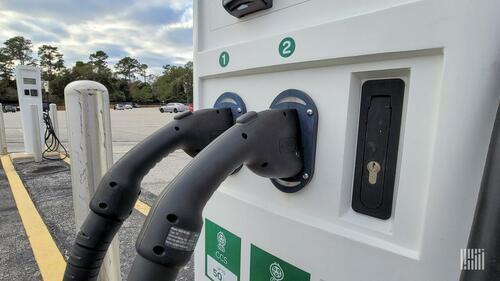By Thomas Wasson of FreightWaves
A newly released report by ChargerHelp! shows that while 64% of Americans now live within two miles of an electric vehicle charging station, nearly one-third of charging attempts fail. Despite charging infrastructure showing 98.7% to 99% uptime rates, only 71% of charging attempts actually succeed, according to the 2025 EV Charging Reliability Report.
The report analyzed more than 100,000 sessions across 2,400 chargers. The report argues that instead of focusing on site uptime statistics, the first-time charge success rate (FTCSR) provides a more accurate measure of the driver experience.
“Uptime tells us if a charger is available, but it doesn’t tell us if a driver can actually plug in and get a charge on the first attempt,” said Kameale Terry, CEO of ChargerHelp!, in an interview with FreightWaves. “First-time charge success captures the real driver experience, and by centering on this metric, the industry can close the gap between availability and usability and build the trust needed for mass adoption.”
The complexity of EV charging stems from multiple software systems that must work in harmony, explained Terry, who has nearly a decade of experience in the space.
“Charging stations and electric vehicles are literally computers,” Terry said. “It’s all about these handshakes and how one software understands another software. If you’ve ever been in the software space, then you probably know that sometimes software doesn’t really understand one another.”
When any of these systems sends out firmware or software updates, compatibility issues can arise. As Terry notes, “Sometimes it may create a bit of a wrinkle in that system … maybe the vehicle itself, the battery management system, doesn’t really understand what the charging station is asking of it.”
These technical barriers create real-world problems for EV operators. In one example, a fleet driver might arrive at a station showing a green “available” indicator, only to find that after plugging in, the station fails to initiate authentication or begins the process but returns to the available screen without completing a charge.
Unlike Tesla’s vertically integrated system, most charging infrastructure involves multiple companies developing separate software components for vehicles, hardware, charge management systems, payment processing and connectors. This fragmentation creates interoperability challenges that directly impact consumers.
The report also identified trends in infrastructure aging. Success rates drop from 85% after the first year at new stations to approximately 70% after three years. This often happens because older hardware cannot be upgraded to newer protocols without significant equipment replacement.
“With older stations, some architecturally inside the unit itself cannot be upgraded to the new protocol,” Terry explained. “You would actually have to deploy a new piece of equipment into that unit in order to update it.”
This creates an added wrinkle for site owners using legacy infrastructure. While new vehicles are tested with current charging stations before deployment, they aren’t typically tested with older charging infrastructure, creating potential compatibility gaps.
Another challenge is regulatory oversight limitations. Unlike gasoline pumps, which undergo regular inspections by state authorities, EV charging stations face limited regulatory supervision. While weights and measures departments do monitor publicly deployed charging stations, their focus is primarily on ensuring consumers receive the electrons they’re paying for, not overall system reliability.
“Even if the station isn’t functioning at all, you wouldn’t get your sticker. They’re more so making sure that you’re not cheating the consumer,” Terry explained, adding that private fleet charging infrastructure falls outside this regulatory framework entirely.
The report recommends three key industry improvements: adopting FTCSR as a central metric, implementing preventive maintenance programs rather than relying on short-term hardware fixes, and establishing a collaborative industry approach to standardize protocols and share data.
Despite these challenges, Terry remains optimistic about the future. “It’s a solvable problem,” she said. “Even gas cars, switching from the horse and buggy to gasoline cars … was not an easy thing. But somebody figured it out. We got roadways, we got vehicles, and now we’re inside of this new kind of transition.”
Loading recommendations...
